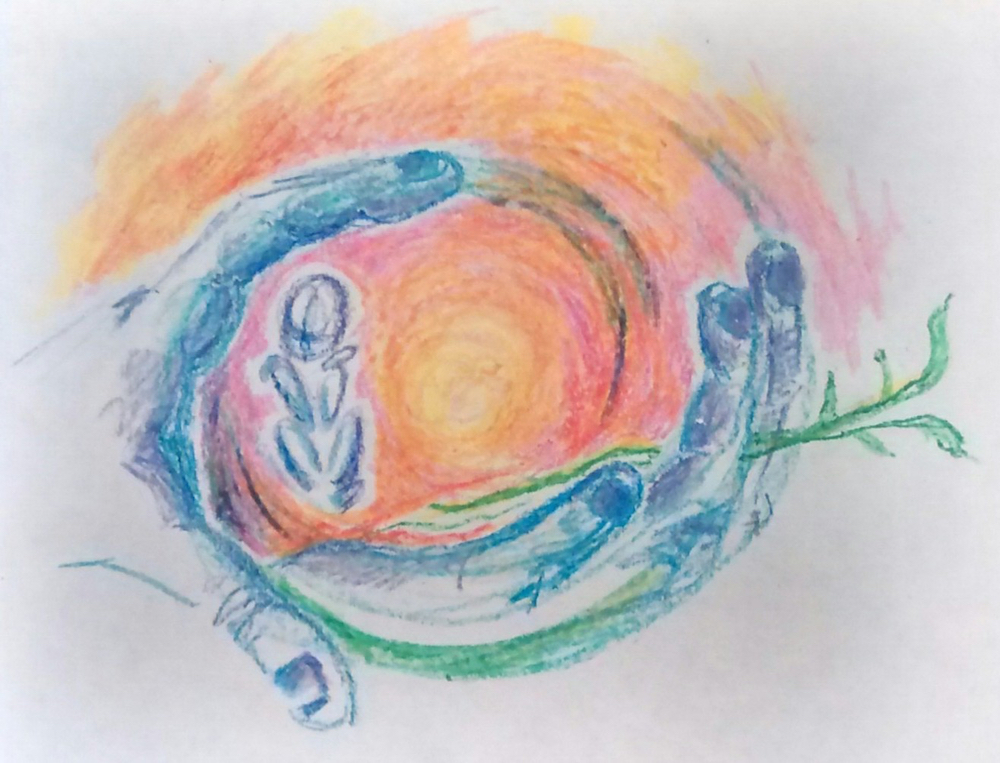From my front yard, I often watch hummingbirds make their nests and sometimes spy tiny, furry animals burrowing into the ground, creating homes. Their homes surround mine, our lives intertwining. There is a creativity to those connections, which nurtures in me a sense of creating in response to my experience of the Divine in creation. I’ve begun to see this creative response to the Divine around us through the making of home, the experience itself of the Divine, and the understanding that when we create (particularly art) we get at something beyond ourselves.
Moving to the coast of Northern California, I was instilled with the awe fit for the oceans and the redwoods. I wanted my home to feel part of nature, and I’ve longed to be part of creation myself. A re-thinking of what it means to be a creative part of creation has helped me see how I get at the Divine.
It is not a long leap to connect my home with the home of creation (the world). The prefix eco is from the Greek word oikos and means “household” – we use it to begin words like economy and ecology. How we see home is both a matter of place and resources.
Broadly, where we call home and what we do with those spaces are issues of creativity. A colleague of mine, Veronica Kyle, who is the Outreach Coordinator for Faith in Place in Chicago, says that we have to see something as beautiful in order to care for it. If we see the place where we live as ugly, we will not be inspired to take good care of it. And so, most of the walls in my house are covered in art – pieces that I’ve made or pieces that have been given to me over the years. This has been the case of every home I’ve lived in, but it feels especially true of this place in which I dwell on the coast of the Pacific Ocean, where the beauty of nature seems to wrap its arms around me. Nature does that – as Mary Alice Armstrong writes in Dianne Glave’s Rooted in the Earth, “one practical result of…nature should be to surround our homes and schoolhouses with the most beautiful thing attainable. It should instill the spirit of creating and preserving the natural beauties of roadside and field and forest rather than that of ruthless destruction.” That is, the beauty of the natural world has made me much more attuned to the beauty with which my home is filled.
That sort of realization can push us to consider context and pay attention to the places we call home so we see the creativity of the Divine around us. In “A Native Hill,” Wendell Berry writes that our deepest questions about our context are, at their core, “religious, because they are asked at the limit of what I know; they acknowledge mystery and honor its presence in the creation.” Thus, when I stand in my yard, slackjawed at the hummingbird hovering over the flowers, I’m honoring the mystery of divine creativity (for what else, I wonder, but imagination cloaked in science leads to such a tiny, beautiful bird?).
But, if we acknowledge creativity as a response to a divine creator, we also have to understand our relationship to the Divine. One of the ways that I’ve begun to understand my creativity is as what theologian Phil Hefner calls “created co-creator.” He suggests that we think about the separateness and connectedness of humanity as making us “created co-creators,” and with this identity, humanity is called to recognize itself not just as made of the topsoil, but also as made in God’s image (Anna Case-Winters explores this more in her book Reconstructing a Theology of Nature). Hefner’s concept of the “created co-creator” asks humanity to consider not just who we are but also how we relate to the rest of creation. How are we to exist as both the created and the co-creator? For me, our created status means that we are made by God, and we are created out of the biological processes of nature. Our co-creator status points out that not only are we meant to see and love the world around us, but we are meant to add to it.
And that requires creativity. Perhaps impossibly, I want to be able to describe what it means to create art in response to experiencing the Divine in creation. From a strictly Protestant standpoint that sets me apart from God, I could feel so inadequate if I believed that only God can create what is beautiful. But, if I see my creativity in solidarity with how all parts of creation create, it is an invitation to connect. It feels like a privilege when I pull out my crayons or my paints to birth an image, but it also feels like a prayer. Colors over colors, lines into lines. Whatever comes next adds to creation.

And so I think about the birds making their nests, and the trees preparing to put their first buds out to the branches, and I feel my own creative juices churning. My spirit aches for the joy of creation in making art and home.
And I ache, too, to connect with other artists. How are you creative? How does that creativity make you feel connected to the world around you?


